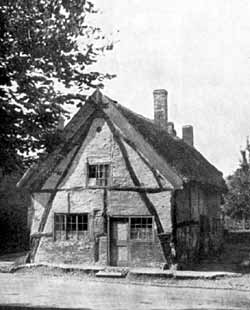A cottage at Sutton Bonington
A note by T. M. BLAGG

House at Sutton Bonington
Demolished 1935
IN that encyclopaedic work, Sir Banister Fletcher’s “History of Architecture on the comparative method” (10th ed. 1938) Nottinghamshire is distinguished by having two of its picturesque cottages chosen for illustrations (p. 416) among the very few examples of English types. One of these is the “cracked” cottage at Sutton Bonington; the other at Normanton-on-Soar.
Although the Normanton cottage yet remains with us, we regretfully record that the more interesting one at Sutton Bonington was pulled down in 1935.
Owing to the greater prosperity of its agriculture in the period 1750-1860, which caused timber and cob and thatched cottages to be replaced by brick and tiled; and owing also to the more early general use of brick for house building, Nottinghamshire has never been so rich in these picturesque cottages as the south and west of England, and such as we had have mostly been “improved away” in recent years, as for instance the entire destruction of the hamlet of “Little London” at Scarrington. We cannot therefore but deplore the loss of Sutton Bonington’s "cracked” cottage.
At Hucknall Torkard the members of the society, on their visit last June, saw an example of this “crack’’ construction at the church porch of that place.
The method consisted in the selection of two massive oak timbers whose natural grain gave them a slightly arc bend; these were laid out flat on the ground and a transverse timber like the transom of the capital letter A morticed on to them and secured by oak pins or trenails. A similar frame was made for the other end and when all was ready they were up-reared to form the two gable-ends, and a roof-tree or rig-beam rested on their apex.
This stage the master-carpenter and his men celebrated by enjoying a “rearing-supper” provided by the owner for whom they were building. The custom still survives in an attenuated form when a flag is stuck on the gable when the roof-timbers are in position and ready for the tiler or slater to get to work and the workmen expect their “'lowance” to mark the stage they have reached.
After being up-reared in this fashion, the frame was further strengthened by studs and massive comer stocks and then the walling filled in with cob or puddled clay laid on reeds; often the lower half of the walls were more substantially built of rag-stone or the narrow bricks of the period, either in courses, “clumps,” or herring-bone patterns.
When in position the crucks have very much the outline of the pairs of whale jaw-bones seen as garden-arches in the Trent-side villages, which were brought back as trophies on the fore-peak of Hull whalers after a successful voyage.
Sir Banister Fletcher has kindly allowed me to use the illustration given in his work, which was published by Messrs. B. T. Batsford, Ltd.
